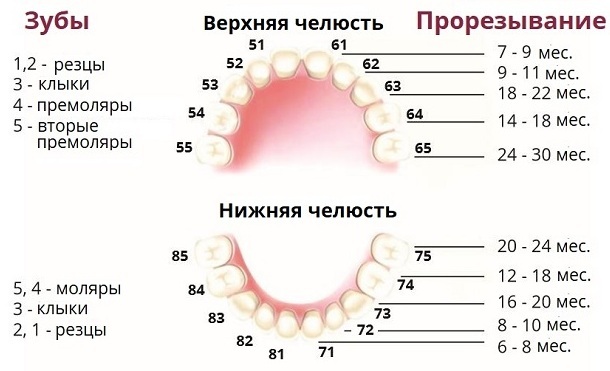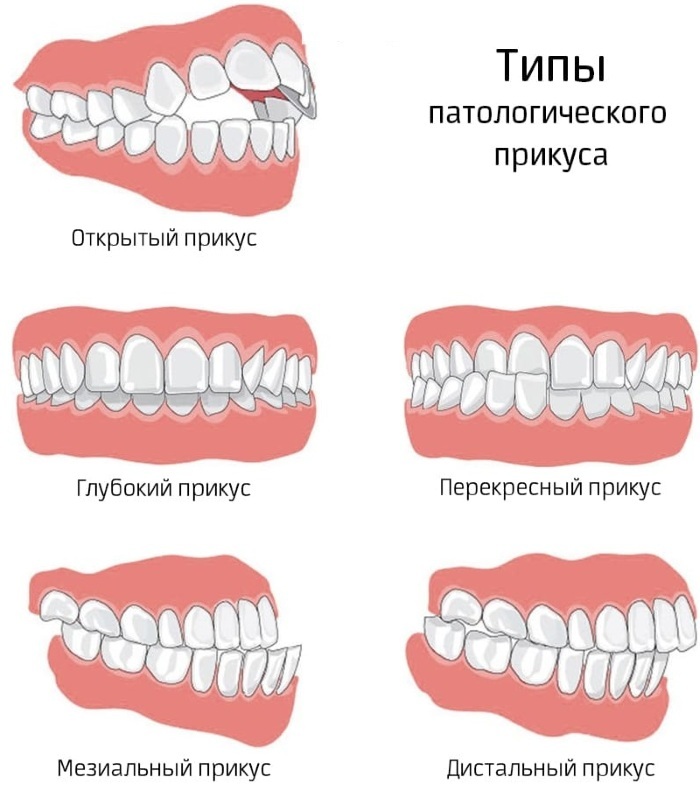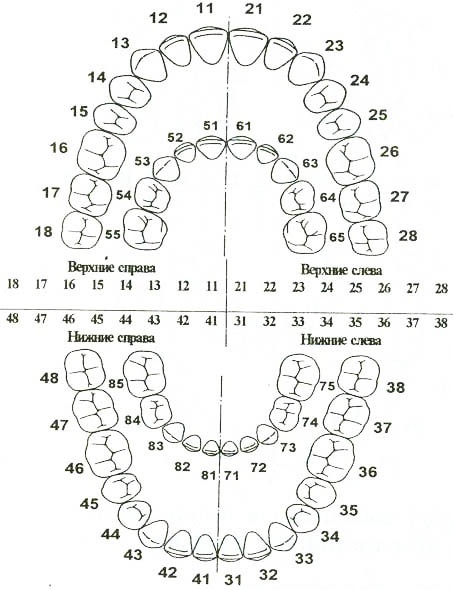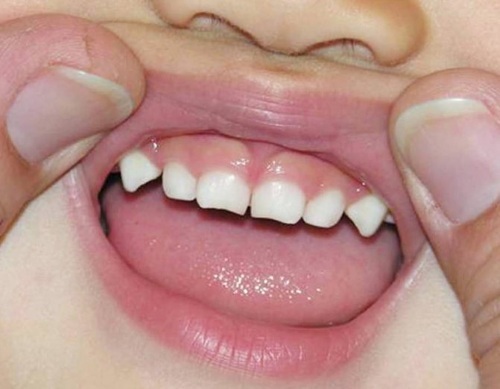A person grows several types of teeth (also called dental or dental units by experts). They are extensions of hard tissue that form in the jaw.
Many people mistakenly believe that teeth are the same in structure as bones, but these processes are much stronger than bone material and differ from it in structure. The main function of teeth is not only chewing food, they are also a necessary component of the human speech apparatus.
Record content:
- 1 Components of a tooth
- 2 Milk and molar teeth
- 3 What is a masticatory apparatus?
- 4 What is a dental formula?
- 5 Bite - the interaction between the teeth of the upper and lower jaw
-
6 By what principle are teeth numbered according to different classification systems
- 6.1 Universal system
- 6.2 European system
- 6.3 Haderup system
- 6.4 Siegmond-Palmer system
-
7 Types of teeth in humans
- 7.1 Incisors
- 7.2 Fangs
- 7.3 Premolars
- 7.4 Molars
-
8 Alternative names of human teeth
- 8.1 Eye teeth
- 8.2 Wisdom tooth
- 9 Correct names of milk teeth
-
10 Why are jaw pathologies dangerous?
- 10.1 Pathologies of the upper and lower row of teeth
- 11 Video about human teeth
Components of a tooth
Histology is a science that studies the structure of teeth and the living organisms present on them. Teeth are made up of several components, each of which has an important function.
| Material name | Description |
| Enamel | It is the top layer of the tooth, which is first covered by the cuticle. When saliva is secreted, a special protective shell is formed on the enamel, which is called a pellicle. |
| Dentine | The base of the tooth. By its structure, dentin is very similar to bone tissue. But this material has increased strength due to the saturation with minerals. Dentin is a layer that is located in places where there is no enamel. That is, the dentin layer can be called protective. |
| Pulp | It is a spongy-type connective tissue. The pulp contains the vessels and nerves of the tooth. |
| Cement | It is a bone tissue that covers the neck and root of the tooth. Thanks to the cement, the teeth are fixed in the alveolus. |
Milk and molar teeth
In humans, teeth change as they grow older (between the ages of 5 and 12). The first teeth that erupt in a child are called milk (temporary) teeth. They form at the age of 4-6 months (sometimes a little later). A total of 20 such dental units grow.
When a child turns 5-6 years old, milk teeth are replaced by permanent ones - molars. This process takes several years. The final change of dental units is completed by the age of 10-12. The child has 28 teeth.
After that, additional teeth grow, located at the end of each dentition. We are talking about wisdom teeth. There are 4 of them in total: one from each edge of the upper and lower rows. Wisdom teeth can be fully developed by the age of 25, and in some they fully grow at the age of 30-40.
In medical practice, cases have been recorded when these dental units erupted at 60 and even 70 years. This variation is due to a person's genetic predisposition.
What is a masticatory apparatus?
This is a full-fledged system, on the quality of work of which the vital activity of a person depends.
The chewing and speech apparatus consists of:
- the facial skeleton, as well as the temporomandibular joint;
- muscle tissue;
- sound and speech apparatus;
- organs that carry out the function of capturing and moving food further into the pharynx;
- teeth;
- glands of the oral cavity.
These bodies are interconnected. If certain deviations occur in one of the systems, then the work of the entire chewing-speech apparatus is disrupted. This often affects other systems of the human body.
What is a dental formula?
Dental formula (diagram) is an abbreviated description of the dentoalveolar apparatus. For designation, numbers and letters of the Latin alphabet are used.
Based on this scheme, there are 4 types of teeth:
- I - incisors;
- C - canines;
- P - premolars;
- M - molars.

The formula of a healthy person with all formed dental units looks like this: I2 / 2C1 / 1P2 / 2M3 / 3 = 32. That is, on each jaw there are 2 pairs of incisors, 1 pair of canines, and so on.
The dental formula may vary depending on the condition of the dentition. That is, in the documents, the doctor may indicate not P2 / 2, but P1 / 2, this will mean that the patient does not have enough premolars. If one of the groups is completely absent, then 0 is indicated next to the letter of the Latin alphabet.
Also, the doctor can indicate the formula, compiled on an individual basis, if the patient has certain abnormalities, for example, when a tooth grows in the wrong place. This can happen with hyperdontia, polydontia and other pathologies.
Bite - the interaction between the teeth of the upper and lower jaw
The types of teeth in humans allow the doctor to determine their location. The bite also plays an important role (experts often call it occlusion). It represents a special position of the two dental arches during the closing of the upper as well as the lower jaw.
Permanent occlusion is formed when the deciduous teeth are replaced by molars. The bite can be correct or incorrect. Pathological occlusion is also distinguished.
With correct occlusion (doctors call this type orthognathic), the dentition should close symmetrically. Due to this bite, a person's face acquires the correct and proportional features. Also, the upper teeth slightly overlap the lower dentition. Then the person develops the most attractive smile (from the point of view of physiology).
Thanks to the correct bite, people speak beautifully, and chewing food does not cause discomfort to them. It is important that with such an occlusion there is a uniform load on the lower dentition.
In this case, the teeth will stay healthy longer and the person will not need the help of a specialist. However, this type of bite is extremely rare. More often in people, some changes are noted in the process of joining the dentition.
It is customary to distinguish the following types of bite:
- Progenic. This type of bite belongs to the pathological variety. In this case, the lower row of teeth is slightly pushed forward. The jaws close normally, therefore, from the point of view of physiology, this occlusion is not capable of bringing discomfort to a person.
- Straight. This bite is very similar to the previous one. The difference is that the incisors are very tightly pressed against each other when the jaw is closed. Because of this, both tooth rows are at the same level. A level bite can provoke a number of problems, primarily due to the fact that in this position the teeth begin to wear off much faster. Correction is recommended for such occlusion.
-
Biprognathic. With this bite, both tooth rows move forward slightly. The jaw is closed correctly. This type of occlusion does not require intervention by a doctor, therefore, orthodontic constructions are not used for correction.

- Distal. In this case, the front incisors protrude forward, which cover the lower teeth. Due to this arrangement of the teeth, a person has to make significant efforts to close his lips. This also causes another defect - the lower part of the face looks much smaller than the upper one. That is, it looks disproportionate. With distal occlusion, caries and various periodontal diseases are much more often diagnosed in patients. Also, due to this type of bite, early loss of teeth occurs, a person experiences severe discomfort while chewing food. Diction is additionally disturbed. A person often suffers from ENT diseases. Posture problems may even appear. Therefore, if possible, the dentist tries to correct the distal occlusion.
- Mesial (this bite is also called medial). This form of occlusion is characterized by a very strong extension of the lower jaw. In this case, the lower incisors cover the upper ones. Such a bite is not so common. In this case, the person's face also changes. It looks a little concave, as the chin protrudes very much forward in relation to other areas of the face. As a result of such occlusion, various diseases of the gums and teeth can develop. Because of such a distortion, it hurts a person to eat, he complains that he hears constant clicks while moving his jaws. With such a bite, the doctor cannot perform the prosthetics or implantation procedure.
- Deep. This type of occlusion is very similar to a normal bite. However, in such a situation, there is an increased load on the permanent teeth. This anomaly can provoke a traumatic bite. Then the lower incisors will begin to overlap the upper teeth by almost 1/2. Against the background of such an occlusion, permanent trauma to the gums occurs, which is fraught with the loss of teeth. The shape of the lips gradually changes. Also, due to the deep bite, patients often complain of headaches.
- Open. This type of bite is considered the most difficult, as it is characterized by an incomplete jaw connection. Such occlusion is of the pathological type, that is, it is a disease, which, in turn, is divided into three categories. An open bite can be anterior, rickety, or traumatic. In the first case, a person's lateral incisors do not close. This causes various problems with diction in a person, the shape of the face begins to lengthen, patients complain that it hurts them to chew and swallow food. The traumatic type of pathology usually develops if the child begins to lose milk teeth too early or in case of damage to the jaw or face as a whole. If we are talking about adults, then such problems can arise against the background of bad habits.
- Cross. With such an occlusion, the jaw closes correctly, but only in certain areas. The bite is so named because it strongly resembles a pair of scissors. It is very difficult for a person with this type of occlusion to chew food, which can lead to pathologies of the digestive system.
By what principle are teeth numbered according to different classification systems
The types of teeth in humans differ not only in letter designation, but also in numbering. Usually it depends on the order in which the eruption of dental units occurs. They begin to count from the front incisors, that is, from the center of the jaw. After that, the teeth are counted in two directions (to the left and to the right of the incisors). There are several systems by which teeth are numbered.
Universal system
In such a system, teeth are not called using Latin letters, but ordinary serial numbers are used for this, that is, Arabic numerals, which are more familiar.
According to the universal system, teeth are classified as follows:
- The central incisors, which are located in the center of the jaws, are indicated by the number 1. Dentists often refer to these teeth as units.
- The twos are the second incisors. They are numbered accordingly (number 2).
- Fangs are called triplets.
- Fours and fives are chewing teeth as well as premolars. They are numbered 4 and 5.
- Molars are 6, 7 and 8 teeth. They are indicated accordingly.
The jaw itself, according to this system, is divided into 4 main segments. That is, it can be top left and right, as well as bottom left and right. Also, when examining a patient, the doctor can indicate the location of diseased or deformed teeth on a graphical diagram showing all dental units.
The universal tooth numbering system is used in many countries, including Russia.
European system
The types of teeth can be numbered according to another system. It is considered the most modern and newer when examining a person at a dentist's appointment. In this case, the jaw is also divided into 4 segments (2 at the bottom and 2 at the top), each of which is numbered from 1 to 4.
Based on this, each tooth is assigned not a single, but a two-digit number. The first digit is the segment of the jaw in which the unit is located, and the second is the actual serial number.
The European Viola system is considered international. It is often used for X-ray examinations or when taking panoramic images.
Since this system is universal, it allows dentists from different countries to exchange the necessary information about their patients. At the same time, doctors may not speak other languages and communicate freely by using only alphanumeric characters.
Haderup system
According to this system, Arabic numerals are used, and the jaw is divided into 2 segments: upper and lower. In the first case, the doctor indicates the symbol "+", and in the second indicates the jaw, as "-".
But this system is not that popular. Since only 2 segments are used to define the jaw zone, the doctor has to indicate which side the dental unit belongs to.
Siegmond-Palmer system
This is the most unpopular system. In this case, doctors indicate only the tooth number. In what area of the jaw it is located, the dentist does not write. In this case, the classic numbers of the Arabic alphabet are used. This system has already been almost completely abandoned in the diagnosis and treatment of teeth.
Types of teeth in humans
Having considered the numbering and location of the teeth, it is worthwhile to learn more about their features. Each type of dental unit performs its own function, the violation of which can lead to problems with the bite.
Incisors
The types of teeth in humans are not very diverse. The incisors are the central (frontal) teeth. They can be distinguished by the incisal edge, flat crown and root of a simple form (single). The frontal part of the crown of such a tooth is more convex. Behind the incisors, on the contrary, are slightly concave. Several small tubercles are located near the neck of the teeth.
In the upper incisors, the crown is the largest. The lower incisors have the smallest crowns of all. Thanks to the incisors, a person can bite off food. However, these dental units are the weakest.
Therefore, it is impossible to exert increased chewing and other loads on them. However, the incisors have the optimal shape and structure so that a person can effectively bite off food.
Fangs
They are 4 teeth located at the corners of the dental arches. Fangs are necessary in order to pull off the hard and dense part of the food. These teeth are used for food that the incisors cannot handle.
Canines are distinguished by more powerful crowns, therefore, they are much more stable than incisors. There is a tubercle along the cutting edge of such a dental unit. There is also only one root of such a tooth. However, it is much longer and more powerful than that of the incisor.
Due to the convenient location of these teeth and the peculiarities of their structure, they are the most stable. Canines are the least likely to break from food that is too hard and are less likely to be damaged by tooth decay.
Premolars
This is the name of the small molars that are located behind the canines and are very similar to them. However, premolars differ in structure. For example, they have not one, but two bumps. This allows the person to tear apart and grab food.
Premolars have an enlarged crown. Therefore, they also take part in chewing food. Also, the difference is that the first premolar has 2 roots. The rest of the teeth of this type have only one root.
Molars
This is the name of the largest teeth that are located behind the premolars. There can be 2-3 of them on each jaw. The third molar is a wisdom tooth. Molars are necessary for a person in order to grind and grind food. Therefore, teeth of this type are distinguished by a large crown, on which a very wide chewing surface is located.
Also, this tooth has 3-5 tubercles. Painters located on the lower jaw have two roots. The upper teeth are tighter. They have 3 roots. There are cases when 4 or even 5 roots are found in the upper molars.
The wisdom teeth located on the upper and lower jaw are constantly at a very small distance from each other. Often, neighboring dental units even grow together, which entails complex dental problems.
The greatest harm to the bite is caused by the absence of premolars and molars. For most of a person's life, a person has only 28 teeth, since eights sometimes grow very late. But since they are located in a place difficult to clean, they are most often damaged by caries and, ultimately, they must be removed.
Alternative names of human teeth
In addition to the official names of teeth, there are also secondary ones. As a rule, they are not indicated on official documents and dental records. However, in a conversation with a patient, the dentist may use informal names to make it easier to explain which dental units need treatment.
Eye teeth
The types of teeth in humans include this informal category.  Ophthalmic teeth are the upper canines that are closest to the branches of the facial nerve. If the process of inflammation of the eye teeth begins, then a person may experience pain not only in the gums, but also in the area of the eyes or other upper parts of the face.
Ophthalmic teeth are the upper canines that are closest to the branches of the facial nerve. If the process of inflammation of the eye teeth begins, then a person may experience pain not only in the gums, but also in the area of the eyes or other upper parts of the face.
Wisdom tooth
This is the popular name for posterior third molars. These dental units got their name, since they appear at that age when a person is already formed and has a certain wisdom.
Correct names of milk teeth
Milk dental units represent the first set of teeth that grow in humans. They got their name, as they appear at a time when the child is still breastfed. Their anatomy is not much different from the structure of permanent teeth. However, they have shortened roots, due to which the change is much easier.
The names of milk teeth also do not differ from the names of the indigenous dental units. That is, the child also has central incisors, canines, lateral incisors, first and second molars. But there are no molars in this case.
Why are jaw pathologies dangerous?
With pathologies of the jaws, a person can develop lesions of the temporomandibular joint. In some situations, atrophy may even occur or the tone of the masticatory muscles may decrease. Because of this, a person cannot eat normally.
Pathologies of the upper and lower row of teeth
Often, patients are diagnosed with hypoplasia of enamel organs. In this case, chalk-like spots form on the teeth of a person. It is also possible to develop hyperplasia. It is characterized by deposits that begin to cover the teeth.

With the development of such anomalies, the lesion gradually begins to affect the entire dentition. Sensitivity to hot and cold increases. If you do not start treatment in a timely manner, the damage will be irreversible, that is, some of the teeth will have to be removed, which will entail a change in the bite.
Due to dental pathologies, the following can develop:
- endocrine diseases;
- infectious pathologies;
- anatomical or physiological defects.
In addition, a person may develop arthritis. It is an inflammatory lesion that affects the joints. Local infection or trauma to the maxillofacial area can lead to this pathology. In the case of advanced dental pathology, arthrosis can be diagnosed. This is a dystrophic lesion that is localized in the articular cartilage.
If a person cannot chew food normally, then he begins to swallow it in large pieces. Therefore, sometimes dental problems can lead to obesity. There are other complications as well.
For example, a person may develop temporal joint pain dysfunction. In this case, the patient experiences frequent pain in the temple area. As a rule, such problems are faced by people who have a large number of teeth missing or have a serious malocclusion.
Regardless of the type of teeth, each of them plays a big role in human life. If he is diagnosed with caries or other dental pathologies, then gradually the dental units are destroyed. Severe pain and inflammation appear. Therefore, it is recommended to periodically visit the dentist to identify possible pathologies at the initial stage.
Video about human teeth
Tooth Anatomy:

